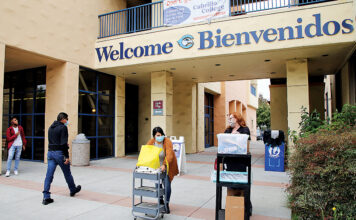Seacliff Beach is unique because it has a fishing pier that extends out to a 100 year old concrete ship. Storms have not been kind to the ship and the last few storms made it hard to imagine what it used to look like. How did it get there and why would anyone make a ship out of concrete?
When the United States officially entered World War I. German submarines were taking a heavy toll on our ships. By 1918, our government began an $8 billion ship building program to replace those ships. Nicolay Knudtzon Fougner, a Norwegian civil engineer, had been working on reinforced concrete ship technology and had actually built several. He and his brother Hermann convinced the U.S. Shipping Board Emergency Fleet Corporation to embark on a program to build 38 concrete ships. Only eight were completed.
By 1919, The San Francisco Shipbuilding Company was constructing the S.S. Palo Alto and her sister ship S.S. Peralta at the U.S. Naval Shipyard in Oakland. These ships were 435 foot long, 7,500 ton oil tankers. The war ended before they were completed.
Concrete does not seem like it would float, but neither does steel. It has to do with water displacement. Concrete hulls are relatively thin. The Palo Alto’s hull is five inches thick on the bottom and four inches thick on the sides. The hull has seven times more steel reinforcing rod than would be required for dry land cement work. The cement used to build the hull came from Davenport and puffed brick was substituted for half of the required gravel to lighten the weight. It is possible that some of this brick was rubble left over from the 1906 San Francisco earthquake.
The S.S. Palo Alto was launched sideways on May 29, 1919. The hull was completed in 120 days from the first pour. She was outfitted with a 2,800 horsepower steam engine, a fifteen foot, eleven ton, bronze propeller and white Norwegian ash decks. She had 14 water tight oil compartments with a capacity of 3 million gallons. Her estimated cost was $1.5 million.
The Palo Alto was commissioned in October 1920, eleven months after the war’s end. The Palo Alto made only two short voyages under her own power. On January 2nd, 1921 she sailed from the ship yard in Alameda to the Hunter’s Point drydock and on January 24th from there to Pier 33 in San Francisco. Because concrete ships were brittle, they were not popular in peace time. Palo Alto lay at anchor for the next four years and was sold for the scrap price of $18,750. She was stripped of her engine and propeller and sold to the Seacliff Amusement Corporation in 1929. The Red Stack tug, Sea Scout, towed her to Seacliff Beach where she arrived January 22, 1930. She was drawn up toward the beach and sunk onto the sandy bottom on January 25th.
A 630 foot pier was built out to the ship’s stern and she was refitted as a pleasure ship with a dance floor, a cafe, a 54 foot heated swimming pool and concessions, including slot machines, bingo and other games of chance. The Rainbow Ballroom opened Saturday, June 21, 1930 to a crowd of 3,000 people. According to Dick Firebaugh of Freedom, whose father was the ship’s night watchman, gambling went on below deck. “Bootleg whiskey” was delivered directly onto the ship by rum runners. Rio Del Mar beach was notorious as a landing spot for illegal liquor during prohibition. Dick recalled one night when his father scarred off a rum runner’s boat with the ship’s search light.
The ship was open for two summer seasons and was very popular, but the pleasure ship was pummeled by five major storms before succumbing to the 1932 storm that cracked the ship’s hull. That same year, the Seacliff Amusement Corporation went bankrupt. The ship was stripped of its valuables in 1934. The ship was sold to the state in 1936 for one dollar. Aptos centenarian, Ralph Mattison had the running lights and donated them to the Seacliff State Beach visitor center.
The relentless pounding of the sea has taken its toll on the Concrete Ship and the pier. After the ship became part of Seacliff State Beach, visitors were originally allowed to walk or fish from the deck. Annual children’s fishing derbies were held. A gangway across the break in the hull, allowed people access to the foredeck. The foredeck was eventually closed in 1958 as unsafe. As a result of heavy weather in January 1978, the pier and the ship were closed for almost 5 years. Rose Costa, Harry Haney and Ed Nelson spearheaded an effort to repair and reopen the pier and the ship which were successfully reopened on July 23, 1983. Continuing assaults by the ocean lead to a permanent closure of the ship in 1998.
Originally, the ship sat at the same level as the pier, but it eventually began to settle into the seabed. Heavy weather in January of 2016 broke the rear section of the ship and separated it from the middle and front sections. On January 21, 2017, 34 foot storm swells, the largest recorded since records were kept, caused the rear section of the ship to roll onto its side. The Concrete Ship, S.S. Palo Alto, has gone from Big Band music to Rock and Roll.
Celebrate the ship’s centennial with us. Learn about the building of the S.S. Palo Alto
and how it came to Seacliff Beach at our “Coffee, Tea and History” presentation, Saturday, May 18, 2:00pm to 3:30 pm, at the Rio Sands Hotel Community Room, 116 Aptos Beach Dr. Kevin Newhouse and Bob Wall will be the presenters. $25 general, $20 museum members, Friends of SC State Parks and students. An historic walking tour to the Seacliff Visitor Center will follow the presentation and will be conducted by Dick Garwood. Reservations only, (831) 688-1467.
Specially designed T-shirts to commemorate the centennial of the ship will be available for $20 at the event or now at the Aptos Chamber of Commerce, 7605 Old Dominion Court, 688-1467.











